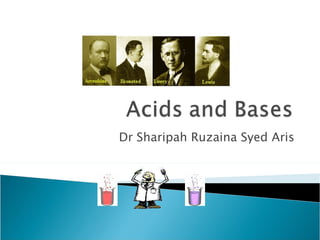Acids and bases
- 1. Dr Sharipah Ruzaina Syed Aris
- 2. Acid : substance that yields hydrogen ions (H+) when dissolved in water. Exp: HCl (hydrochloric acid), HNO 3 (nitric acid) Base : substance that yields hydroxide ions (OH-) when dissolved in water. Exp: NaOH (sodium hydroxide), KOH (potassium hydroxide)
- 3. Aqueous acid and base solutions conduct electricity. Acid and base react each other to produce ionic substance called salts Acid Base Sour taste Bitter taste and feel slippery Change colour of litmus from blue to red Change colour of litmus from red to blue Change the colour of basic phenolphthalein from pink to colorless Change the colour of basic phenolphthalein from colorless to pink React with certain metals such as Zn, Mg and iron to produce H 2 gas - React with carbonates and bicarbonates to produce CO 2 gas -
- 4. Arrhenius Concept Bronsted-Lowry Concept Lewis Concept
- 5. acid: generates [H + ] in solution base: generates [OH - ] in solution normal Arrhenius equation: acid + base ÔÇ´ salt + water example: HCl(aq) + NaOH(aq) ÔÇ´ NaCl(aq) + H 2 O(l) Very limited and apply to aqueous solutions only.
- 6. Bronsted acid: anything that donates a [H + ] ( proton donor ) Bronsted base: anything that accepts a [H + ] ( proton acceptor ) normal Br√∏nsted-Lowery equation: acid + base ÔÇ´ acid + base
- 7. example: HNO 2 (aq) -> H + (aq) + Cl - (aq) (HNO 2 bronsted acid because it donates a proton in water) Ionization of HNO 2 HNO 2 (aq) + H 2 O(aq) ÔÇ´ NO 2 - (aq)+ H 3 O + (aq) Each acid has a conjugate base and each base has a conjugate acid . These conjugate pairs only differ by a proton . In this example: NO 2 - is the conjugate base of the acid HNO 2 and H 3 O + (hydronium ion)is the conjugate acid of the base H 2 O.
- 8. NH 3 (g) + H 2 O (l) -> NH 4 + (aq) + OH – (aq)
- 9. Monoprotic acids: acids that are able to donate one proton per molecule during the process of dissociation (sometimes called ionization) Exp: hydrochloric acid (HCl), nitric acid (HNO 3 ) acetic acid (CH 3 COOH). Diprotic acids: acids that are able to donate two proton s per molecule during the process of dissociation exp: H 2 SO 4 Triprotic acids: acids that are able to donate three proton s per molecule during the process of dissociation exp: H 3 PO 4 , H 2 PO 4 -
- 10. acid: accepts an electron pair base: donates an electron pair The advantage of this theory is that many more reactions can be considered acid-base reactions because they do not have to occur in solution.
- 11. Strong Acid Weak Acids Ionize completely in water (HCl, HNO 3 , HClO 4 , H 2 SO 4 ) Have weak conjugate base Partially Ionize in water (NH 4 + , HF, CH 3 COOH) At equilibrium, aq solutions of weak acids contain a mixture of nonionized acid molecules, H 3 O + ions and the conjugate base. Have strong conjugate base Strong Base Weak Base Strong electrolyte that ionize completely in water (alkaline metal and certain alkaline earth metals) Weak electrolyte. Exp: Ammonia Normally have lone pair





![acid: generates [H + ] in solution base: generates [OH - ] in solution normal Arrhenius equation: acid + base ÔÇ´ salt + water example: HCl(aq) + NaOH(aq) ÔÇ´ NaCl(aq) + H 2 O(l) Very limited and apply to aqueous solutions only.](https://image.slidesharecdn.com/acidsandbases-111027204921-phpapp02/85/Acids-and-bases-5-320.jpg)
![Bronsted acid: anything that donates a [H + ] ( proton donor ) Bronsted base: anything that accepts a [H + ] ( proton acceptor ) normal Br√∏nsted-Lowery equation: acid + base ÔÇ´ acid + base](https://image.slidesharecdn.com/acidsandbases-111027204921-phpapp02/85/Acids-and-bases-6-320.jpg)




